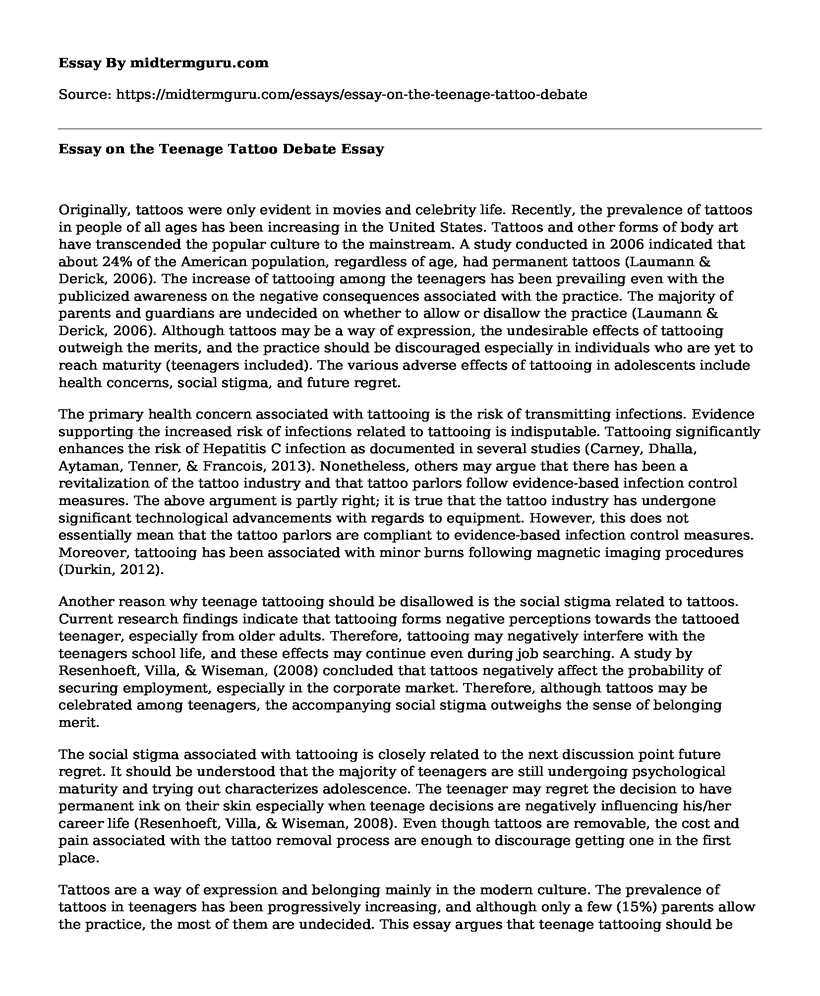Originally, tattoos were only evident in movies and celebrity life. Recently, the prevalence of tattoos in people of all ages has been increasing in the United States. Tattoos and other forms of body art have transcended the popular culture to the mainstream. A study conducted in 2006 indicated that about 24% of the American population, regardless of age, had permanent tattoos (Laumann & Derick, 2006). The increase of tattooing among the teenagers has been prevailing even with the publicized awareness on the negative consequences associated with the practice. The majority of parents and guardians are undecided on whether to allow or disallow the practice (Laumann & Derick, 2006). Although tattoos may be a way of expression, the undesirable effects of tattooing outweigh the merits, and the practice should be discouraged especially in individuals who are yet to reach maturity (teenagers included). The various adverse effects of tattooing in adolescents include health concerns, social stigma, and future regret.
The primary health concern associated with tattooing is the risk of transmitting infections. Evidence supporting the increased risk of infections related to tattooing is indisputable. Tattooing significantly enhances the risk of Hepatitis C infection as documented in several studies (Carney, Dhalla, Aytaman, Tenner, & Francois, 2013). Nonetheless, others may argue that there has been a revitalization of the tattoo industry and that tattoo parlors follow evidence-based infection control measures. The above argument is partly right; it is true that the tattoo industry has undergone significant technological advancements with regards to equipment. However, this does not essentially mean that the tattoo parlors are compliant to evidence-based infection control measures. Moreover, tattooing has been associated with minor burns following magnetic imaging procedures (Durkin, 2012).
Another reason why teenage tattooing should be disallowed is the social stigma related to tattoos. Current research findings indicate that tattooing forms negative perceptions towards the tattooed teenager, especially from older adults. Therefore, tattooing may negatively interfere with the teenagers school life, and these effects may continue even during job searching. A study by Resenhoeft, Villa, & Wiseman, (2008) concluded that tattoos negatively affect the probability of securing employment, especially in the corporate market. Therefore, although tattoos may be celebrated among teenagers, the accompanying social stigma outweighs the sense of belonging merit.
The social stigma associated with tattooing is closely related to the next discussion point future regret. It should be understood that the majority of teenagers are still undergoing psychological maturity and trying out characterizes adolescence. The teenager may regret the decision to have permanent ink on their skin especially when teenage decisions are negatively influencing his/her career life (Resenhoeft, Villa, & Wiseman, 2008). Even though tattoos are removable, the cost and pain associated with the tattoo removal process are enough to discourage getting one in the first place.
Tattoos are a way of expression and belonging mainly in the modern culture. The prevalence of tattoos in teenagers has been progressively increasing, and although only a few (15%) parents allow the practice, the most of them are undecided. This essay argues that teenage tattooing should be disallowed because the negative consequences outweigh the merits. Among the reasons discussed herein include the increased risk of infections, social stigma and the teenager regretting the decision to have a tattoo in his/her future.
References
Carney, K., Dhalla, S., Aytaman, A., Tenner, C., & Francois, F. (2013). Association of tattooing and hepatitis C virus infection: A multicenter case-control study. Hepatology, 57(6), 2117-2123. http://dx.doi.org/10.1002/hep.26245
Durkin, S. (2012). Tattoos, Body Piercing, and Healthcare Concerns. Journal of Radiology Nursing, 31(1), 20-25. http://dx.doi.org/10.1016/j.jradnu.2011.09.001
Laumann, A. & Derick, A. (2006). Tattoos and body piercings in the United States: A national data set. Journal of The American Academy of Dermatology, 55(3), 413-421. http://dx.doi.org/10.1016/j.jaad.2006.03.026
Resenhoeft, A., Villa, J., & Wiseman, D. (2008). Tattoos Can Harm Perceptions: A Study and Suggestions. Journal of American College Health, 56(5), 593-596. http://dx.doi.org/10.3200/jach.56.5.593-596
Cite this page
Essay on the Teenage Tattoo Debate. (2021, May 26). Retrieved from https://midtermguru.com/essays/essay-on-the-teenage-tattoo-debate
If you are the original author of this essay and no longer wish to have it published on the midtermguru.com website, please click below to request its removal:
- Ideas for Feature Drama Film - Paper Example
- Essay on Cece Winans as an Activist Through her Music and Career
- Article Analysis Essay on Effects of Prenatal Music Exposure
- Paper Example on Music of the 20th Century: Claude Debussy
- UX Design Graduate School: Personal Statement
- Video Analysis Essay on 'The Price of the Ticket' by James Baldwin's
- Reflective Essay on American Museum of Natural History







